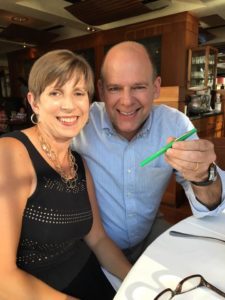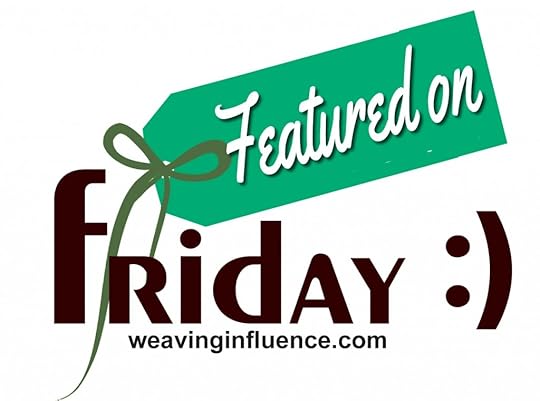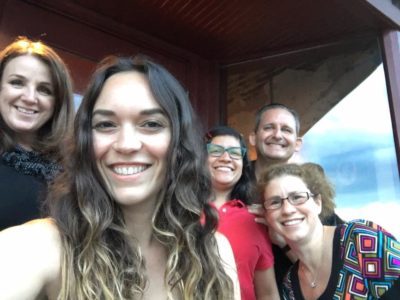Becky Robinson's Blog, page 54
August 19, 2016
Featured On Friday: Meet the Team with @k_giovanoli
You may know Weaving Influence as a [mostly] virtual team. There are, however, a select few who work in-person from the Lambertville, MI office. One of those team members is Kayla Giovanoli, a recent graduate from the University of Toledo. Kayla is one of the younger members of our team who has really hit the ground running, contributing enormous value to Weaving Influence. She certainly has a bright future ahead of her!
Kayla, tell us a bit about your personal life and interests.
I am a proud alumnus of The University of Toledo, I hold a B.A. in Communications and a focus in Public Relations. I have been employed with Weaving Influence as a Social Media Specialist since last September. Recently I have taken on a new role with Weaving Influence’s sister company, Hometown Reads, as Community Manager.
I live in Oregon, OH with my fiancé Noel and our black Cockapoo Rocco… We are excited to become parents to a baby boy this fall!
Tell us about how you connected with Weaving Influence.
I found Weaving Influence through my internship at Susan G. Komen. My supervisor at the time forwarded me the link to the job posting, and told me she thought I would be a good fit. I ended up applying, only to hear that I was too late and candidates had already been selected. As fate would have it, Becky was running a race later that week where Susan G. Komen had a booth set up. She ended up talking to my supervisor and decided to call me and give me an interview! The rest is history!
What is your favorite part of your job?

I love being able to do different things everyday. Working with social media is always exciting and changing, I like that it keeps me interested and never gets monotonous. Working on so many different projects has allowed me to develop different skills and helped me learn what I enjoy doing.
What is your favorite book and why?
Harry Potter Series of course! I’m still waiting for my owl telling me I’ve been accepted to Hogwarts.
Connect with Kayla!
Facebook: https://www.facebook.com/kayla.giovanoli
Email: kayla@weavinginfluence.com
Twitter: @k_giovanoli
August 18, 2016
Levers of #Influence
This post is part of our 2016 Team Buzz Builder Guest Blogger series. Today we are pleased to introduce you to David Sparks, author of the inspiring SparkVoice blog.
Years ago I took a team position inside of major manufacturing company with no direct reports, but one that required specific outcomes. To achieve any positive outcome in my new role, influence was a must.
Over the last five years, I have discovered that to succeed in building levers of influence, you must do four things: be consistent, knowledgeable, honest, and a problem solver.
CONSISTENCY
Darren Hardy has said, “Consistency is the key to achieving and maintaining momentum.” When you are a model of consistency, you demonstrate you are reliable. People count on you to do what you say you will do. When people ask you to do something, they know you will do it as agreed. Over time, they will give you greater and greater responsibility, which allows you to have greater influence. Remember that being reliable doesn’t mean being “not creative.”
KNOWLEDGEABLE
One of the best ways to gain traction for influence is to demonstrate you have knowledge regarding a subject. It not only requires information from a book, but also practical knowledge. This allows you to be believable. This is especially helpful if you are an expert in an area that those you are influencing are not. In this way you bring a unique skill and trait. Billionaire entrepreneur, Shark Tank mogul, and NBA owner Mark Cuban strongly believes in gaining an information advantage, saying: “To this day, I feel like if I put in enough time consuming all the information available, particularly with the net making it so readily available, I can get an advantage in any technology business.”
HONEST
When you are honest, it is easy to build trust and influence. People know that your word matters — when you commit to something, you will do it. When you provide data, it is good data. Your honesty will allow people to trust your motives. John C. Maxwell rightly said, “You build trust with others each time you choose integrity over image, truth over convenience, or honor over personal gain.” When you desire to build influence, there is no greater tool than honesty as it goes hand in hand with integrity.
PROBLEM SOLVER
It is easy to find problems. It is easy to point out mistakes. What’s not easy is discovering solutions, identifying opportunities for improvement, and driving those through conclusion. It’s easy to blame others while skirting your own responsibilities within a process. When you are able to take yourself and your pride out of the situation, you allow the causes of a problem to be identified and allow solutions to come out. In situations you have faced in the past, where did you find yourself operating – -within the problem-finding space, or the problem-solving space? Once people find out you are a partner in resolving problems, you will become more involved across your organization increasing your influence.
While it’s easy to look out across the horizon and express a desire to be an influencer, true influence takes more than notoriety. tweet this
It requires work behind the scenes that is consistent, knowledgeable, honest, and driven to resolve problems. You will see the greatest results while embracing all of these levers — but even beginning one, you will see your influence grow over time.
 David Sparks has a mission is to help ordinary people do extraordinary things. Therefore he writes and speaks about encouragement, simple ways to serve others, choosing to act, positive resources, and inspiring stories. He has an MBA in Organizational Development and Leadership from Oklahoma Christian University, and works for a major manufacturing company. He’d love to connect with you in the comments below, on his blog, or via Twitter.
David Sparks has a mission is to help ordinary people do extraordinary things. Therefore he writes and speaks about encouragement, simple ways to serve others, choosing to act, positive resources, and inspiring stories. He has an MBA in Organizational Development and Leadership from Oklahoma Christian University, and works for a major manufacturing company. He’d love to connect with you in the comments below, on his blog, or via Twitter.
Copyright: joggi2002 / 123RF Stock Photo
August 16, 2016
How to Reawaken Your Curiosity and Never Stop Learning
I am a bookworm, no question about it. I learned to read at age 3 and haven’t stopped since. Yet when I was recently asked what my favorite hobby was, I hesitated to say reading. Because that word by itself doesn’t quite say enough — after all, do I mean reading fiction? non-fiction? magazines? blogs? all of the above?
I took some time to consider how to define what I enjoy doing more than anything else, and finally narrowed it down to one overarching theme: feeding my curiosity. That incorporates many different activities, but all with the same end in mind — reading both fiction and nonfiction, exploring nature, learning new skills, practicing hobbies, trying new experiences, and just being inquisitive about life in general.
The word curiosity is defined as “inquisitiveness; the tendency to ask and learn about things by asking questions, investigating, or exploring.” And I think that explains my mentality pretty well! But it hasn’t always been that way.
I used to take everything at face value, rarely digging beneath the surface of words or actions, and never letting myself wonder about the why’s and how’s of people, places, things, and ideas. I didn’t do anything to feed my curiosity, and so it became stagnant and forgotten.
But then something sparked my interest, and I started digging deeper, not because I had to for work or school, but simply because I wanted to learn something for my own personal enjoyment.
Know what the neat thing is about curiosity? The more you feed it, the greater it grows.
Once you start asking questions, the more questions start coming to mind. Once you open your mind to explore the world around you, the more places you discover to keep exploring. Once you begin investigating the why’s and how’s of people and ideas, the more you start wondering and inquiring about.
I still have a ways to go in certain areas. I’m not nearly curious enough about people (hello #ISTJ!), and there are certainly a few topics I simply have no interest in learning about (umm… wastewater management, anyone?). But keeping an attitude of curiosity lets me constantly be amazed by mysteries of God’s creation, captivated by the depth and variety of personalities in this world, and intrigued by humanity’s progress (or lack thereof) over the past eight thousand years on this earth.
For instance, we recently moved to a small town in western Wyoming. After living in eastern states for several decades of life, I find myself captivated by the vast differences in topography, wildlife, industries, and mindsets between the two coasts. I find myself spending hours learning the names of all the wildflowers I see, and asking all sorts of questions about the plethora of wildlife that roams freely around the area. I’m exploring subjects I’d never given a thought to before — like the history of coal mining, the unique science of high elevation, and the expeditions of Lewis and Clark. Just one reason I’m thankful to live in an age where information is so readily available to us!
My point is this: the more I explore and learn, the more I want to explore and learn.
Maybe you’re not very curious. Maybe nothing new has sparked your interest in a long time, or maybe you’re simply too stressed or tired to pay attention to the fascinating world around you. Perhaps the bugle call of Netflix has drowned out the whispers of exploration and learning, or the contentment of the “known” has overshadowed the uncertainty of trying something new.
What can you do about it? How can you reawaken your sense of curiosity?
Take a few minutes today and try one of these ideas:
Google everything. Crowd-sourcing is great, but often you get simplistic answers without further explanations. Continue asking your social networks for help, but don’t stop there: next time, take 5-10 minutes to dig a little deeper online.
Get to know someone better. Make a note in your planner to spend 5 minutes today with someone you don’t know very well. Ask a coworker about their favorite hobbies, call an acquaintance to ask how they’re doing this week, or simply reach out to your neighbor across the street (cookies are always welcome, of course!).
Read, read, read. Reading awakens your curiosity no matter what genre you prefer. Not only does it keep your mind agile, but it lets you explore “strange new worlds” and awakens your interest in ideas. In fact, a recent study even confirmed a link between reading (even just 30 minutes per day) and a longer lifespan! Pick up a new book and read a chapter or two before going to bed tonight.
Let your mind wander. Stop scheduling activity for every.single.moment of every day. Instead, schedule 5-10 minutes (maybe during that afternoon slump?) to pause and daydream: ponder something out of the ordinary, explore the why’s and how’s behind what you see and hear each day, or simply let your mind contemplate some new venture or idea.
Use your smartphone. Forget social networks or games: the Curiosity app provides a fast, easy, and free way to keep learning something every day. It shares 5 short new facts every day, which you can simply scroll through or tap to learn more. You can also access it on the web if you’re not a smartphone user.
Keep a journal. All those things you’re starting to learn or be curious about? Write down one of them every day. Then review your list at the end of each week and pick one thing to learn about in more detail. Note: it doesn’t have to be time-consuming or deep; your entries could be as short as one sentence and as simple as noting a few details about someone you met or a book you want to check out.
Take a free class. It takes just a moment to bookmark this site or this site for a rainy day, and start thinking of a topic you’d like to learn more about — whether it’s related to your job or not! Every subject has something to teach us and applications that reach into myriad realms of life. For an added bonus, consider asking some friends or coworkers to sign up for a class with you. You’ll build stronger relationships and learn something new at the same time!
My goal is to never stop learning: how about you? tweet this
Tell me something! How do you feed your curiosity on a regular basis?
Image credit: underverse / 123RF Stock Photo
August 12, 2016
Featured on Friday: Challenge Yourself with This Week’s #MustReads!
Where has the summer gone?! I’m thankful to not be governed by the school calendar this year, but August still feels like a “transition month” to me. It’s summer’s last hurrah; everyone’s trying to squeeze in one more vacation, and school is gearing up for students, parents, and teachers. Even those like me, who don’t have a family member in school, are influenced by the rhythms of the educational calendar.
Personally, I always try to re-evaluate my routines towards the end of the summer, whether they’re related to wellness habits or finances or time management. It feels like a good time to pause, reflect on what we’ve accomplished so far this year, and recalibrate before jumping into the last four months of the year. It’s not January, of course, but that doesn’t mean we can’t set new resolutions or goals: we still have time to reset our focus and challenge ourselves before the end of the year.
How about you? Here’s a few must-read links from recent weeks that might help you reassess your goals — and maybe even set some new ones!
If you’re looking for a change of scenery in your job — or if you’re just curious which organizations are most loved by their employees — check out this list from Anthology of the 40 Best Companies to Work For in 2016. Unfortunately, they forgot to include the very best one of all… Weaving Influence, of course!

August 9, 2016
Fur, Crystals, and Being More of You
When our CEO, Becky Robinson, went to the Berrett-Koehler Marketing Workshop in San Francisco recently, she came away from a client interaction with one 8-word takeaway that resonated enough to make it to her personal Facebook wall as well as our internal Slack dialogue.
What were those eight profound words from Dan Negroni?
Be more of you, it works way better.
A book I read recently supported that idea and prompted me to be more appreciative of the unique gifts I can bring to my work and my life, whether or not they fit into the conventional expectations of others. First, the takeaways, then the reveal of the book.
You Do You
The author discussed how she had tried to mold her mannerisms, voice inflections, and dress to the group she was hanging out with and wanted to be accepted by. Calling herself a “chameleon,” she talked about how she adapted a full-on British accent after the vacation she took in England at the age of 13. Throughout college, she became so immersed in her “pier” peer group, losing all vestiges of her unique self in favor of duplicating their characteristics that one of them finally took her aside to point out that they loved her for the fact that she was her, not the fact that she was going to extreme lengths to look, sound, and act exactly like them.
You’re already fabulous, so just be yourself.
~Max, The Honest Friend
Celebrate Your Competition
We all have choices to make, day in and day out, about how to conduct ourselves when we are players on the field of commerce. I have watched and taken notes as our CEO Becky and the Weaving Influence team propose how our services will be configured and priced to potential clients (or returning clients).
Personally, I have fought envy when fellow bloggers get more lucrative sponsorship opportunities or are selected over me to represent causes I feel I could represent well. When I read that I can’t apply for a certain opportunity because I don’t have, for example, 50,000 UMVs (Unique Monthly Views), it’s easy to feel that the requirement is unfair, since I could prepare a blog post that is as effective as someone with 50,000 UMVs.
But bloggers with 50,000 (or however many) UMVs got to that point by hustling, nurturing community among their followers, and applying themselves. I must choose whether I am going to pout about it in my little corner of the cyberworld or say “good for you” to them while celebrating their success (and taking notes about what I can do to get there).
A favorite passage in the book related to competition:
When competition gets fierce … it’s easy to get down on [those] gunning for you.
Fill your heart with gratitude and thank every single one of them for making you try harder, risk more, and be better than you ever would have been without them. Without the people who are constantly trying to outshine us, we would be the big, giant C word: complacent.
Our Job: Teasing Out Our Clients’ Fabulosity
I was on a conference call with a client recently. As a group, we were all struggling with one particular piece of our business together, but it was a piece that is fundamental to the long-term success of that client: pinning down a “tagline,” a distillation of what this client does so that it can be easily digested before a viewer loses interest and decides to click off of the client’s web page.
In the midst of an hour-long meeting, there was one five-minute or so period where the client was talking about the part of her work that she loves. She talked about receiving letters from people who believe their lives have been changed for the better. Of women who didn’t previously think they could get a promotion who asserted themselves and acquired new positions. Everything about our client’s voice and demeanor gained an additional “sparkle” as she talked about this part of her work.
As the book emphasizes:
Hang on to what sets you apart, because that is what makes you special.
She is already fabulous. She does need to keep being herself. It is our job to help turn that passionate tone of voice and the joy with which she spoke of that work into a consistent social media presence that sparkles too.
How Do People Know You’ve Been in the Room?
I have intentionally withheld the name of the book which made such an impression on me (but you don’t have to wait much longer!).
Here’s a quote that sort of gives it away (a big, pink, furry, crystal-studded hint anyway):
…some women just start pretending they’re one of the guys, as if taking up golf and dressing in a suit will magically make their pay gap disappear. It’s a mistake.
I stayed true to who I was. For example, I covered my headphones with pink fur and crystals, so if anyone walked into my studio, they knew who they were getting right away.
Every boss I’ve ever had has seen my headphones and has said, “Of course you have pink fuzzy headphones,” and that was it. I love that I am who I am, and everyone else should too.
~ Michelle Visage, Author, The Diva Rules
Why does THAT passage prod me to think about what being “The Big Green Pen” means for me? It doesn’t mean I’m going to run out and bedazzle my green pen. It means owning the things that make me “me”: being committed to using language well (including correct grammar and punctuation!), encouraging people to find causes they feel strongly about and to move “beyond the hashtag” to tangibly impact those causes, inspiring people to “write optimistically,” whether they are composing a 140-character tweet or their first novel.
It means when I hand you a green pen (even if it’s not furry or crystal-encrusted), that I have taken the time to get to know you and determined from our interaction that you are making a positive difference in your part of the world. It means Of course you deserve your own big green pen. Below – when I gave our Mark Miller his own green pen!

Yes, the book that inspired me so much is a bit different than our typical Weaving Influence fare. I can’t recall any of our previous books that had sparkly letters on the cover, hot pink zebra print inner linings, or “color block” tables of content. But all of those things make this book by a woman who has built a thriving career, including being a television personality, radio show host, platinum-selling recording artist, and entertainment industry celebrity with a three-decade tenure, uniquely “her” while dispensing credible advice.
How can YOU be “more of you”?
August 5, 2016
Featured On Friday: #WITour2016
I have to say, being part of a virtual team is AWESOME. Not only do I get all the benefits from working from home (from as far as Israel!), but I don’t necessarily miss out on the personal interactions that come from a traditional shared work environment because of Weaving Influence’s collaborative nature. WI is not only a team, its a community, and I am grateful for that.
Needless to say, I was still a bit envious of those team members that were able to get together over the past few weeks in Atlanta, and was very excited to hear about all of the connections made at the Berrett-Koehler marketing workshop in San Francisco where Becky spoke to an outstanding group of authors and marketing professionals.
Here, I have compiled some thoughts from team members who were a part of the in-person 2016 Weaving Influence tour (#WITour2016!).
It was so wonderful to meet some of the team members I work with on a daily basis in person. It was like seeing celebrities or unicorns or fairies… They really do exist! –Whitney Heins, PR Director
Working in a virtual team doesn’t mean you don’t have strong support and collaboration with your co-workers, but it is different. When we get the opportunity to get together in person, it feels almost like a reunion–even if it’s the first time we’re meeting in person. The value of these get-togethers is that they deepen our connections with one another and truly solidify our feeling of community. Meeting with clients in person has the same effect-we get to connect on a deeper level and I think the work is better for it. I wouldn’t trade my virtual job, but I love moments for in-person connection. The balance is what makes successful partnerships and teams. –Christy Kirk, Director of Social Strategy
We have the good fortune to work on a virtual team, which gives us a great deal of flexibility. Thanks to technology, we “see” each other (over video conferences, for example) frequently. When I met Kylah, Whitney, and Christy in person (I had met Becky before), it was an uncanny combination of “this doesn’t feel like a first meeting” and “it’s so great to FINALLY MEET YOU!” There is a special power in looking someone in the eyes (and breaking bread with them, which we did our fair share of on this trip), and I am so grateful that Weaving Influence encouraged us to leave our keyboards and headsets behind in order to spend time together “in real life.” – Paula Kiger, Community Manager
Even though you may meet with and work with a person via video calls, email and chat every day, there’s something about that face to face meeting in real life and sharing real space that can’t be replicated in the virtual world. I was so grateful to have gotten the chance to officially meet co-workers and clients alike in Atlanta. –Kylah Frazier, Project Manager

Becky with our client Charles Vogl
It’s always invigorating to meet face to face with those we work with, especially so in a virtual company such as ours. My wife and I just happened to be passing through Atlanta at the same time as other team members and we met for dinner. Even just a few minutes of face time makes a considerable difference. –John Marcello, Web Developer
“In addition to loving the chance to connect with team and clients face to face, I enjoyed the deep learning and conversation at the BK Workshop.” –Becky Robinson, CEO
I’m still waiting for #WITourMiddleEast. Until then, I can live vicariously through my teammates.
Have a fantastic Friday! I hope you take some time this weekend to connect with friends and loved ones in person.
August 2, 2016
Going Back to School on Storytelling
It’s back to school season! And, recently I found myself going back to school of sorts when I stumbled upon some old public relations textbooks. Thumbing through them, I thought—“Geez, if I wrote like this, readers would fall asleep halfway through the lede!”
Much has changed since I went to school: the media landscape has widened and shifted; yet while the number of outlets seem to multiply at an exponential rate, the number of top-tier outlets remains the same. Instead, they’re just more people and organizations clambering for coverage in them.
And audiences today are able to consume news at any moment in time—but for shorter spurts. They’re less likely to read long features. Stories tend to be under 700 words and are simplistic and pithy.
Yet even with these changes, the core job of a public relations professional has stayed the same.
We are storytellers.
But the way we tell stories to grab the attention of news generators and consumers is different.
So, in the spirit of the back-to-school season, I’m going back to school on how to hook media and their audiences—and thought you’d like to tag along.
First things first, though. There has and always will be only two main ways to grab attention: 1) Make a story either with fresh content, research, op-eds, events, or content marketing/creation; or 2) follow a story by offering expertise or a different angle to a news event.
Without doing this, your hopes of being written or talked about is just that—hopes.
With this in mind, here are 9 ways to frame stories so that they grab attention of the media and their audiences:
Be useful. Readers today gravitate to stories that promise them something that’s easy to read and simple to do.
Be immediate. Words like daily, now, today, immediately get reads.
Tell secrets. Words like secrets, habits, tricks, tips, and characteristics catch people’s eyes.
Pique curiosity. Keep them guessing in the headline.
Leverage your experience. Promote the information you have that audiences can’t find elsewhere.
Name drop. Use big names seen in the top headlines.
Cite weird numbers. Think 35, 19, 11. These tend to get clicks.
Talk big price tags. Big dollar amounts also pique interest.
Be universal. Share lessons that can benefit anyone.
The media will also want to know what value your story will have for their audiences. So when thinking of your story, ask yourself why people should care and what makes it unique or new. Then leverage that and share your story!
Image credit: ValeriaMoschet
July 29, 2016
Featured on Friday: #FindYourVoice as a Leader @voiceasaleader
As a blogger and book author, I’ve spent a lot of time considering the ripples of influence. For instance: if I spend 30 minutes writing a blog post, that post may be read by someone across the country, who may then take the truths I’ve shared and use them to encourage another friend, who may then make adjustments in their life for the better… (etc., etc., etc.). Of course, not every post has that sort of influence spiral; but the point is, I must consider ahead of time what I want my impact to be since, as they say: if you aim at nothing, you’ll hit it every time!
And it’s the same for everyone. Whether you’re a writer or a CEO or a stay-at-home parent, you need to own your individual impact. We each need to take time to figure out what we hope to accomplish in our unique roles, determine the values we want to uphold, and then take strategic steps to accomplish that. Philip Larsen, author of the newly released Find Your Voice as a Leader, offers an effective five-step strategy to help us each maximize our potential as leaders — whether you’re leading at home or in the boardroom.
Meet Paul Larsen
 Paul N. Larsen, MA, CPPC, is a Certified Professional Performance Coach and an experienced leadership consultant and speaker. He has over 30 years’ business experience with executive and senior-level responsibilities within small and large companies, including being the Chief Human Resources Officer for a $3 billion organization. Paul partners with industry-wide leaders and teams from Fortune 100, start-up, and high-tech environments to find their unique leadership “VOICE” and create compelling and purposeful outcomes for their organizations. He has a proven track record with organizations such as SAP, Electronic Arts Twitter, and Walmart. Read more at www.paulnlarsen.com, and connect with him on Twitter @voiceasaleader.
Paul N. Larsen, MA, CPPC, is a Certified Professional Performance Coach and an experienced leadership consultant and speaker. He has over 30 years’ business experience with executive and senior-level responsibilities within small and large companies, including being the Chief Human Resources Officer for a $3 billion organization. Paul partners with industry-wide leaders and teams from Fortune 100, start-up, and high-tech environments to find their unique leadership “VOICE” and create compelling and purposeful outcomes for their organizations. He has a proven track record with organizations such as SAP, Electronic Arts Twitter, and Walmart. Read more at www.paulnlarsen.com, and connect with him on Twitter @voiceasaleader.
Discover How to Find Your Voice as a Leader
“Offering concrete steps and guidance to develop greater self awareness, this book shows you what being authentic really means and how to work on being your best self. It equips you with the tools and skills necessary to be the catalyst of positive change your organization needs.“
—Susan Friedmann, CSP, International bestselling author of ‘Riches in Niches: How to Make it BIG in a small Market.’
Are leaders born or made? Research says only 10-15 percent are natural born leaders. And Paul Larsen, top executive coach and business consultant, agrees. That’s why he’s authored Find Your VOICE as a Leader, a book poised to help leaders in all aspects of life find their voice and make an impact.
Through his common-sense V-O-I-C-E model, readers can follow five simple steps to uncover their leadership brand and put it into action. The model has been used successfully by leaders within organizations such as Twitter and Walmart.
Finding your V-O-I-C-E means:
Discovering your core Values. What’s really important to you?
Creating a compelling vision to obtain the Outcomes you want. Is your vision congruent with your values?
Building relationships with Influence and credibility. How do you engage with people to achieve your outcomes?
Making decisions that reveal your Courage and confidence to take a stand. Where do you need to step outside your comfort zone to be the leader you want to be?
Communicating your overall Expression for lasting impact. How can you express your leadership brand?

Check out what some of our Buzz Builders have to say about Find Your Voice…
“For anyone beginning their leadership journey or those who may have lost their effective leadership way, Find Your Voice will be helpful tool. . . . The ’10 steps to lead courageously’ and the ‘6 phrases a leader should never use’ are sections every leader should read periodically to make certain bad habits haven’t seeped into their interactions.” {Read the rest of Jane Perdue‘s review on Amazon.}
“Find Your Voice as a Leader by Paul N. Larsen is my dream book for seasoned and new up and coming leaders. I wish I had this book when I was just starting out in the world . . . It was a welcoming journey through building, influencing, and standing up for leadership – my leadership. Again, this book is a gift to anyone who has wandered off the leadership path or is a young leader. So many young people would benefit from learning about being leaders the ‘right’ way not by watching those that ‘think’ that they are leaders. I strongly encourage you to pick Paul N Larsen’s book today and start your own leadership journey or mentoring someone close to you!” {See what else Lisa Kosak shares in her Amazon review.}
Support the Launch
First of all – if you haven’t already – buy the book! (Amazon: US | Canada | UK | Australia)
Then leave a review – we love reviews, and can never see enough of them show up on Amazon!
Write about it on your blog and send us the link so we can share it.
Share the graphics & send the tweets from the book site through your social channels.
Add it to your Goodreads shelf for others to find.
July 26, 2016
The Heart of An Author’s Online Influence
As our CEO Becky Robinson likes to say, your website is the only place online that you really control online. For that reason, we consider it the essential foundation for building stable and influential thought leadership in your field.
For authors, having a website that effectively communicates with your readers and potential readers about who you are will help to build community around your book(s), engage your readership, and encourage sales of your books and other services.
There are a few different types of ways we help our authors develop “home bases” for their messages.
Custom Author Website
As the web projects manager, these are my favorite types of sites to work on, mainly because of how much the author’s unique personality and perspective shines through in a custom designed and developed site. What differentiates a custom site from a simpler templated site (see below) is the scope and complexity of the design and development. Well-made custom sites will feature:
Unique design. A custom site will be designed with your perspective in mind. The more your “home on the web” can serve as a reflection of your personality, the more your site’s visitors will feel connected to you as an individual. Additionally, many clients will have their site designed in accordance with their existing brand to maintain consistency across the digital and printed spheres, a result not as easily accomplished when using a templated website.
Custom pages and features. Typically, the site map will include key pages such as About, Book, Blog, Services, and Contact, though the specifics of your site map and the layout and content of each individual page depends entirely on your personal goals for the site. Some clients require special additional features such as an online store for products, a message board, events calendar, a press page, or a unique display of videos and/or articles, all of which can be seamlessly integrated into a custom site.
Adaptable/scalable structure. When you opt to invest in a custom site, you are setting yourself up for easier integration of updates and changes to your website in the future.
Some examples of custom sites by Weaving Influence include: giantleapconsulting.com, williamhigh.com, johnperkins.org.
A custom site also gives your audience a chance to connect with you on a personal level—and can serve as a primary driver for your other business offerings such as speaking, consulting, and training.
Templated Author Website
A simpler and more straightforward option, the templated site is a great choice for authors who want to maintain a blog and space for people to learn about their work without investing the resources or time associated with a custom site.
A well-executed templated site will feature:
Clear and simple navigation. If using a templated site, your sitemap may be simpler and smaller than with a custom site, but can still contain all of the key pages that you need for your personal brand. As opposed to a custom-designed homepage, your homepage may be your blog page. This allows visitors to your site to immediately engage with your content by reading your posts, commenting, etc.
A modern, clean look. You will still have the ability to customize colors and add custom images to make your templated site your own! A benefit of using a template is that users can often easily add/change images themselves with little to no knowledge of coding.
Check out Becky Robinson’s site—it’s built on a template and looks fantastic!
Book Microsite
A book microsite is essentially a one-page site that is designed to share important information about your book. We have a specific formula for what information can go into a microsite, so customization is minimal. The main benefit of a microsite is that it allows readers to quickly learn about your book, learn about you, and learn how they can buy the book and share about the book with their friends. A book microsite is an incredible tool for book launches (note: as an alternative to a microsite, some authors opt for a Book page on their author website that contains elements from the microsite).
A book microsite includes:
Navigation at the top of the page.
Custom banner graphic.
Option to download a sample chapter.
Share graphics.
Tweets.
Other ways to learn about author, book, purchasing.
Some examples of book microsites include: chessnotcheckers.com, leadlikecaesar.com, the-secret-book.com.
Whatever type of site you decide is best for showcasing your book and other work to the world, make sure that it includes:
Easy Navigation – clear, intuitive menus with obvious buttons for clicking.
Mobile Responsiveness – easily viewable in all formats – iPhone, tablet, Kindle, etc.
Tracking of Metrics – to find out how people come to the site (i.e., by typing in the URL, searching, or via link or referral) so visitors can be turned into regular guests.
Interested in learning how we can help you develop your home online? Contact us to get started!
Image credit: kpgolfpro
July 22, 2016
Featured on Friday: Honoring the Life of Kathy Cramer
A few years ago, we launched a book for visionary thought leader Dr. Kathy Cramer — best-selling author, speaker, psychologist, business consultant, executive coach, and founder of The Cramer Institute in St. Louis, MO.
Today, we are grieved to share that she recently passed away after a short battle with cancer.
Kathy’s departure leaves a gaping hole in the world of leadership. She dedicated her life to the development of Asset-Based Thinking, a way of looking at the world that helps leaders, influencers, and their teams make small shifts in thinking to produce extraordinary impact. She was passionate about showing leaders how to move beyond the status quo and operate in the upper ranges of their potential.
Kathy’s key phrase, “Lead Positive,” has had a lasting impact on thought leadership, and her best-selling book by the same name was selected as one of Inc.’s top 10 books of 2014. Her other best-selling books include the Change The Way You See series, The Coach’s Guide To Asset-Based Thinking, and When Faster Harder Smarter Is Not Enough.
Will you help us honor her life and continue her legacy? Here are a few ideas:
Read the tribute from Legacy.com (and sign the guestbook).
Buy her book on Amazon and discover how to Lead Positive.
Visit her website for more leadership insight.
“What you do as a leader is contagious. Lead positive!” – Kathy Cramer tweet this













